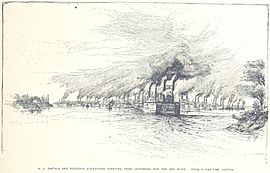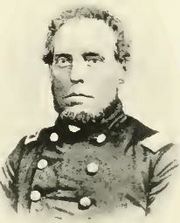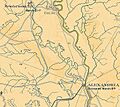Battle of Henderson's Hill facts for kids
Quick facts for kids Battle of Henderson's Hill |
|||||||
|---|---|---|---|---|---|---|---|
| Part of the Trans-Mississippi Theater of the American Civil War |
|||||||
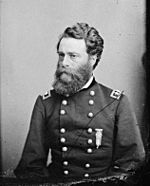 General Joseph Mower led the Union forces. |
|||||||
|
|||||||
| Belligerents | |||||||
| Commanders and leaders | |||||||
| Joseph A. Mower | William G. Vincent | ||||||
| Casualties and losses | |||||||
| negligible | 222–250 men, 4 guns | ||||||
The Battle of Henderson's Hill (also known as Bayou Rapides) happened on March 21, 1864. During this battle, a Union Army force led by Brigadier General Joseph A. Mower tried to trap a Confederate cavalry group with their cannons. The plan worked, and most of the Confederate soldiers were surrounded and captured. This fight was part of the larger Red River campaign during the American Civil War. In this campaign, Union Major General Nathaniel P. Banks tried to capture Shreveport, Louisiana, from Confederate defenders led by Lieutenant General Richard Taylor.
Contents
Why the Battle Happened
The Big Plan
President Abraham Lincoln was worried about France's ruler, Maximilian, who was trying to take control in Mexico. Lincoln wanted the United States to control parts of Texas to show its power. Even though some top generals like Ulysses S. Grant and William T. Sherman didn't agree, Lincoln and Major General Henry Halleck decided to use the Red River in Louisiana as a path for an invasion.
The plan was for General Banks to lead about 17,000 Union soldiers up the Red River. He would meet up with 10,000 more soldiers from General Sherman's army in Alexandria, Louisiana. From there, they would all move up the river towards Shreveport. Another Union general, Frederick Steele, was supposed to bring 15,000 soldiers from Little Rock, Arkansas, to meet Banks. However, Steele's group started late and ended up fighting their own battles.
The Armies Involved
The Confederate army in the area, led by General Edmund Kirby Smith, had about 30,000 soldiers. These soldiers were spread out in three main groups. General Richard Taylor commanded the group in Louisiana.
On the Union side, General A. J. Smith led 10,000 soldiers from General Sherman's army. They traveled on riverboats from Vicksburg, Mississippi. They were joined by 13 "ironclads" (strong, armored warships) and 7 "light-draft gunboats" (smaller, faster warships) led by Rear Admiral David Dixon Porter. General Banks' main force included about 15,300 infantry (foot soldiers) and 4,600 cavalry (soldiers on horseback). There was also a group of 1,500 African-American soldiers.
Early Moves
Admiral Porter's warships entered the Red River on March 12, 1864. The next day, General A. J. Smith's troops landed at Simmesport, Louisiana. The Confederate soldiers in that area quickly moved back to defend Alexandria. On March 14, Smith's troops attacked and captured Fort De Russy. This was a big win for the Union, as they captured 260 Confederate soldiers and many cannons.
At the same time, Porter's fleet broke through obstacles in the river and reached Alexandria on March 15. Union troops occupied Alexandria the next day. Confederate General Taylor pulled his soldiers back to a plantation northwest of Alexandria.
General Banks' main army was late for the planned meeting on March 17. His troops were delayed by bad weather. The Union cavalry arrived in Alexandria on March 19, but the rest of Banks' army didn't get there until March 25–26. Also, the Red River was still too shallow for the big warships to move further upstream.
The Battle Itself
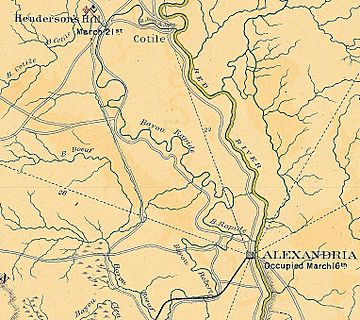
On March 19, the 2nd Louisiana Cavalry, led by William G. Vincent, joined General Taylor's Confederate forces. Taylor sent Vincent's cavalry, along with some cannons, towards Alexandria. They had small fights with the Union soldiers for two days.
Union General A. J. Smith ordered General Mower to take his infantry (foot soldiers) and a cavalry group to scout north. Mower's force included two brigades of infantry and the 9th Indiana Battery (a group of cannons).
On March 21, Mower's group marched north along Bayou Rapides. The Union cavalry pushed Vincent's Confederates back about 7 miles to the southern edge of Henderson's Hill. By the time Mower's foot soldiers arrived, Vincent's troops had set up a defensive line with their cannons. Vincent asked Taylor for more soldiers.
General Mower ordered his cavalry to keep the Confederates busy from the front. At the same time, he sent Colonel Sylvester G. Hill's brigade (a group of soldiers) on a long march around the right side of Vincent's line. The goal was to attack the Confederates from behind. Hill's soldiers, from the 33rd Missouri and 35th Iowa regiments, marched about 8 miles in cold rain and hail.
They got into position at dusk (evening). Hill's troops then charged Vincent's camp from the rear with bayonets (knives attached to rifles). They completely surprised the Confederates, who were only able to fire a few pistol shots. The Confederates were surprised because they thought Hill's troops were reinforcements sent by their own General Taylor.
The Union soldiers captured 222 to 250 Confederate men, 4 cannons, 4 ammunition wagons, and many horses and weapons. Vincent and a few others managed to escape.
General Taylor blamed the loss on "treachery of citizens" who showed the Union soldiers a secret road. One Confederate soldier wrote that Vincent's guards were too far apart. This allowed a "Jayhawker" (a Union supporter in Louisiana) to pretend to be a guard and get a secret password. This Union supporter then gave the password to the Federal camp, which helped the Union soldiers capture the Confederate guards without anyone raising an alarm.
Taylor complained that losing his cavalry meant he couldn't scout the area anymore. However, the Union army didn't push their advantage. Mower's troops returned to Alexandria to wait for the rest of Banks' army. Taylor's forces fell back to Natchitoches, Louisiana and Mansfield. The Battle of Mansfield on April 8 marked the furthest the Union army would advance in the campaign.
Images for kids
-
Map shows Henderson's Hill, Bayou Rapides, and Alexandria. The town of Cotile is now named Boyce.


